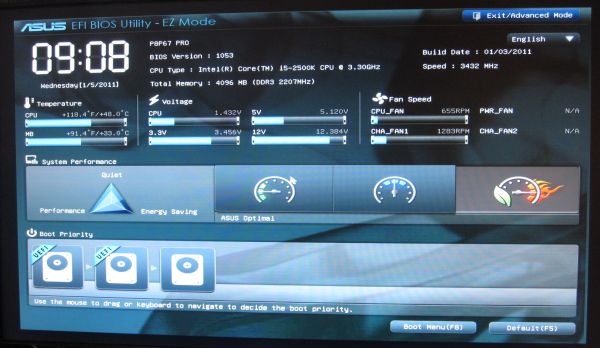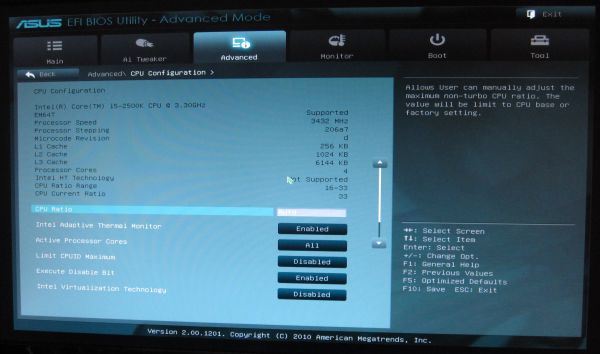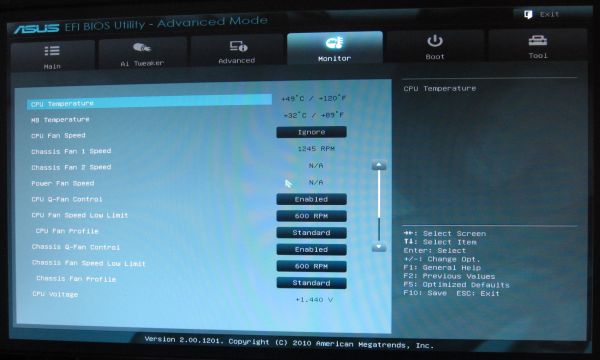The Battle of the P67 Boards - ASUS vs. Gigabyte at $190
by Ian Cutress on January 20, 2011 4:15 PM EST- Posted in
- Motherboards
- Gigabyte
- Asus
- P67
ASUS bring a lot of innovation to the UEFI table over what I have seen from other vendors. The implementation of EZ mode (‘easy’ mode, for us Brits that pronounce that letter ‘zed’) gives the screen below on first entering the UEFI. At a glance, it gives vital motherboard information – CPU, speed, memory, temperatures, voltages, fan speeds, and boot order. The boot order is a great addition, allowing the user to drag-click the order they want. Also available is the three performance options – low power, standard, and performance.
By clicking onto the advanced mode, we get a more BIOS-esque representation of all the motherboard features. The Ai tweaker provides all the overclocking tools we would expect, and more than you find in the Ai Suite in the OS. Features use either a text box for typing values, or a selection box for preset values. The user can utilise the mouse or the keyboard for either task.
Elements such as enhanced sleep states appear under the Advanced CPU Configuration menu, where cores and ratios can be determined. In the Onboard Devices section, if you are not using the Marvell SATA ports, it is advised that this be switched off, to increase boot time by 1-2 seconds.
Fan controls are found in the Monitor tab, where a low limit fan RPM can be given and fan control can be switched between standard/silent/turbo/manual. In manual mode, you can adjust the upper and lower temperature of the fan and at which percentage speed it should run at those temperatures.
Users can specify advanced mode to be shown as soon as the UEFI is selected, and ten UEFI profiles can be saved. The UEFI can also be updated through the Tools tab if the latest file is supplied on a USB drive and plugged in before the ‘update’ option is chosen.
Overclocking
Overclocking on the P8P67 Pro was easy. The UEFI EZ mode offers a performance mode option, which on selecting, enabled the XMP profile of the memory, applied a 103 BCLK, and set the turbo limit to 42x, giving a 4.33 GHz overclock.
As the Ai Suite offers the ‘Auto Tuning’ option, I selected this in the OS and let the program do its thing. After a couple of reboots, and a BSOD, the OS booted into a screen showing a 43x multiplier at 103.5 BCLK (4.45 GHz), and attempted a series of stability tests, slowing increasing the BCLK by 0.5 every 30 seconds. At 105.5 BCLK, a BSOD screen appeared and seemed to crash halfway through, requiring me to reset the system physically. On the next boot, it was stated that the 43x103.5 overclock was applied and now usable. This system is likeable as it promises to adjust depending on how overclockable the processor is.
The downside is that the Ai Suite is quite conservative. I kept with the 103.5 BCLK and went into the UEFI. In advanced mode, adjusting the turbo ratio by one each time and rebooting led to a 46x multiplier (4.76 GHz) successfully passing stability tests. For 47x multiplier (4.86 GHz), I increased the PLL to 1.9V, CPU VCore to 1.42 V, and adjusted the short/long power limits to 150 W/130 W to get a successful stability test pass. This automatically set the memory to a command rate of 3T, so was set back to 1T manually. The 48x multiplier did not boot at this level, and I was not prepared to up the VCore or power limits any more. A 4.86 GHz overclock is very respectable!
At 4.86 GHz (47% OC over 3.3 GHz/non turbo/multithreaded, 31% OC over 3.7 GHz/turbo/single-threaded), the 3D Movement benchmark was run. In single thread mode, a score of 148.92 was achieved, a 31% increase. In multi-threaded mode, a score of 477.60 was achieved, a 37% increase.




















137 Comments
View All Comments
strikeback03 - Friday, January 21, 2011 - link
What board was that? As I have hardly seen any P965 boards which had BIOS updates to support Penryn, let alone older chipsets.I'd imagine the short answer is that it helps Intel's bottom line, and until AMD can produce stuff that competes in performance as well as price Intel will continue to gouge for the chipsets. Also Nvidia charges to SLI certify boards, which is probably why the board makers don't include it in cheaper boards.
Hrel - Friday, January 21, 2011 - link
Asus P5NE-SLI built on the Nvidia 650i SLI chipset.medi01 - Sunday, January 23, 2011 - link
Makes me wonder, how much do they pay for the chipset.I recall buying AMD motherboards supporting the latest CPUs for 50-70$.
Hrel - Thursday, January 20, 2011 - link
I agree with your conclusion whole heartedly. AsRock has really had their game together this past year or so and they don't seem to be slowing down at all. I used to be a strictly Asus guy but AsRock is looking like it'll be the heart to my next build.airgreek - Thursday, January 20, 2011 - link
you do know that Asrock is owned by Asus right? I have been in the PC game a LONG time back when Abit was the mobo to own. I only consider three brands for mobo's now (from experience) and those are MSI, Gigabyte, and EVGA. EVGA has INCREDIBLE customer service, while Gigabyte uses solid material to build their boards. MSI is not far behindPeanutsrevenge - Thursday, January 20, 2011 - link
I agree completely, I LOVE EVGA stuff, it's just not usually suitable for what my customers want, so I don't get to play with their stuff often :(lpjz290 - Friday, January 21, 2011 - link
even though ASrock is a ASUS subsidiary, they are now also considered a competitor ever since they were listed on the taiwan stock exchange. now that they have produced a board that can perform very close to ASUS P8P67 PRO at a considerably lower price, i'd say these two companies could very well be fighting against each other more often in future (which is gd for ASUS as a whole anyway).Hrel - Friday, January 21, 2011 - link
they broke off from Asus, actually.Heloc - Sunday, January 23, 2011 - link
AS of June 2010 ASUS is no longer the majority owner of ASRock but they spun off by issuing shares to ASUS shareholders so both companies have the same board of directors.There is more separation than there was but still than separation than in a simple spin-off.
mckirkus - Thursday, January 20, 2011 - link
If you're doing any surround sound gaming you'll probably want the UD4. It enables Dolby Digital Live which means you can run one optical cable to a receiver and get real surround sound with games without having to resort to a bunch of analog cables. I was about to get a $100 sound card but the UD4 makes that unnecessary.